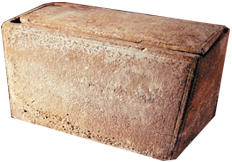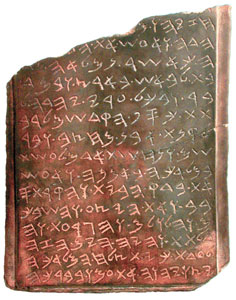Okay, I confess! I am absolutely fascinated by archaeology! I came by it honestly—at the knee of a mother who was similarly fascinated. But, as she pointed out, archaeology is more of an art than a science. Thus the conclusions drawn from discoveries often tend to reflect the preconceptions (not to say, the prejudices) of the archaeologists.
Nowhere is more true than in the realm of Biblical Archaeology. Indeed, use of the word “Biblical “ to describe the subject is regarded as an anathema by many, if not a majority, of archaeologists in the field. The current fashion is to try to interpret excavations in the Holy Land without reference to the Bible.
Frankly, this seems to me to be a bit like trying to circumnavigate the globe without a compass,or reference to longitude, latitude or the position of the heavenly bodies. The reports such folks produce would provide endless hours of innocent amusement to folks who are actually familiar with Holy Scripture were it not for the fact that the results can undermine the faith of Christians (and, of course, Jews) who are not so knowledgeable about the Bible or the fashionable theories that influence so many in archaeologists working in the Holy Land.
This article from the Washington-based Biblical Archaeological Society sheds a little light on the prejudices and politics behind Biblical archaeology today. GPH✠
In late December 2004, four Israelis and a Palestinian Arab were indicted in Jerusalem on charges of running a massive forgery ring. The Israel Antiquities Authority (IAA) and the Israeli police claimed the ring had created millions of dollars–worth of Biblically–related ancient artifacts with forged inscriptions, some of which are exhibited in the prestigious Israel Museum. The trial opened in September 2005 and continued for five years through 116 sessions, 133 witnesses, 200 exhibits, and close to 12,000 pages of testimony from witnesses. Charges against two of the defendants were dropped during the course of the trial and March 14th this year, Judge Aharon Farkash acquitted the two remaining defendants, Tel Aviv collector Oded Golan and antiquities dealer and scholar Robert Deutsch, on all major counts of creating and selling forged antiquities.
Hershal Shanks, founder of the Biblical Archaeological Society, believes that the inscriptions on all three of the major artifacts whose authenticity has been questioned are, in fact, genuine. And he has laid out his reason for believing this to be the case in an ebook entitled: James, Brother of Jesus: The Forgery Trial of the Century. The book can be obtained free of charge from the Biblical Archaeological Society.
Shanks, however, believes the inscriptions will be considered forgeries in the public mind for at least a generation, because they have been declared forgeries, supposedly unanimously, by two committees of the IAA, led by Tel Aviv University Professor and archaeologist Yuval Goren. Among the ancient artifacts the committee has alleged to be forgeries are:
The James Ossuary Inscription: A limestone ossuary inscribed “James, son of Joseph, brother of Jesus.” The Biblical Archaeology Review (BAR) on October 21, 2002, announced: “Amazing as it may sound, a limestone bone box (called an ‘ossuary’) has surfaced in Israel that may once have contained the bones of James, the brother of Jesus.“We know this because an extraordinary inscription incised on one side of the ossuary reads in clear Aramaic letters: ‘James, son of Joseph, brother of Jesus.’” But, writes Shanks, “is this the same James who was the brother of Jesus of Nazareth, or was this another James, whose father happened to be called Joseph and who happened coincidentally also to have a brother named Jesus?” Only the inscription was alleged to be a forgery, the consensus is that the bone box itself is genuine. In his book, Shanks details the reasons for believing the inscription it bears to be genuine.
The Ivory Pomegranate Inscription: The ivory pomegranate inscribed “[Belonging] to the House [Temple] of [Yahwe]h; holy to the priests, ” if authentic, is likely the head of a priestly scepter from the temple of King Solomon. Since 1988 it has been on display in the Israel Museum.
As with the ossuary, there is a consensus that the ivory pomegranate itself is a real ancient artifact; it is only the inscription that has been called into question. Until 2004, there was little question about the inscription’s authenticity—until rumors surfaced that year that the inscription was a fake. A day or two before the forgery indictment was handed down in late December 2004, the Israel Museum announced that a committee had been appointed in conjunction with the IAA to study the pomegranate inscription and that the committee had found evidence that it was a modern forgery.
This was the first the public knew that a committee had been appointed to study the pomegranate and its inscription. At that time, no report whatever had been released. There was no public information as to the basis of the finding.
The names of the members of the committee were kept secret. Even so, BAR learned archaeologist Yuval Goren, who, originally declared all the artifacts to be forgeries (thus clearly an “interested party”) was a member .
The Jehoash Tablet Inscription: The Jehoash inscription is inscribed on a rectangular black stone about the size of a piece of typing paper and consists of 15 lines of Hebrew text. It purports to record repairs to Solomon’s Temple by King Jehoash in the ninth century B.C.E. This description closely parallels the description of Jehoash’s repairs to the Temple as recounted in 2 Kings 12:5-13.When this inscription first surfaced Goren quickly opined that it could not be a real ancient artifact. He claimed it was a forgery because the black stone on which the inscription was carved was not native to Israel and probably came from “the Troodos Massif in Cyprus.” This was soon shown to be absurd. The plaque is made of simple arkosic sandstone, very common in Israel near the Dead Sea, as well as in Sinai.
The most serious claim that the Jehoash inscription is a forgery is philological. Some words in the inscription, some scholars contend, were not in use in the 9th century B.C.E. or not used in the same way at that time. Other scholars take the opposite position.
It was the Jehoash inscription that triggered the investigation that culminated in the forgery indictment in December 2004. The IAA was suspicious of the fact that two such extraordinary inscriptions — the Jehoash inscription and the James ossuary inscription—came to public attention within such a short time from the same source, Israeli antiquities collector Oded Golan.
This led the IAA to appoint a committee to study these two inscriptions. On the basis of Professor Goren’s opinion, the committee declared both inscriptions to be forgeries. This, in turn, ultimately led to the criminal charges.
See the original article for details on downloading the eBook.




